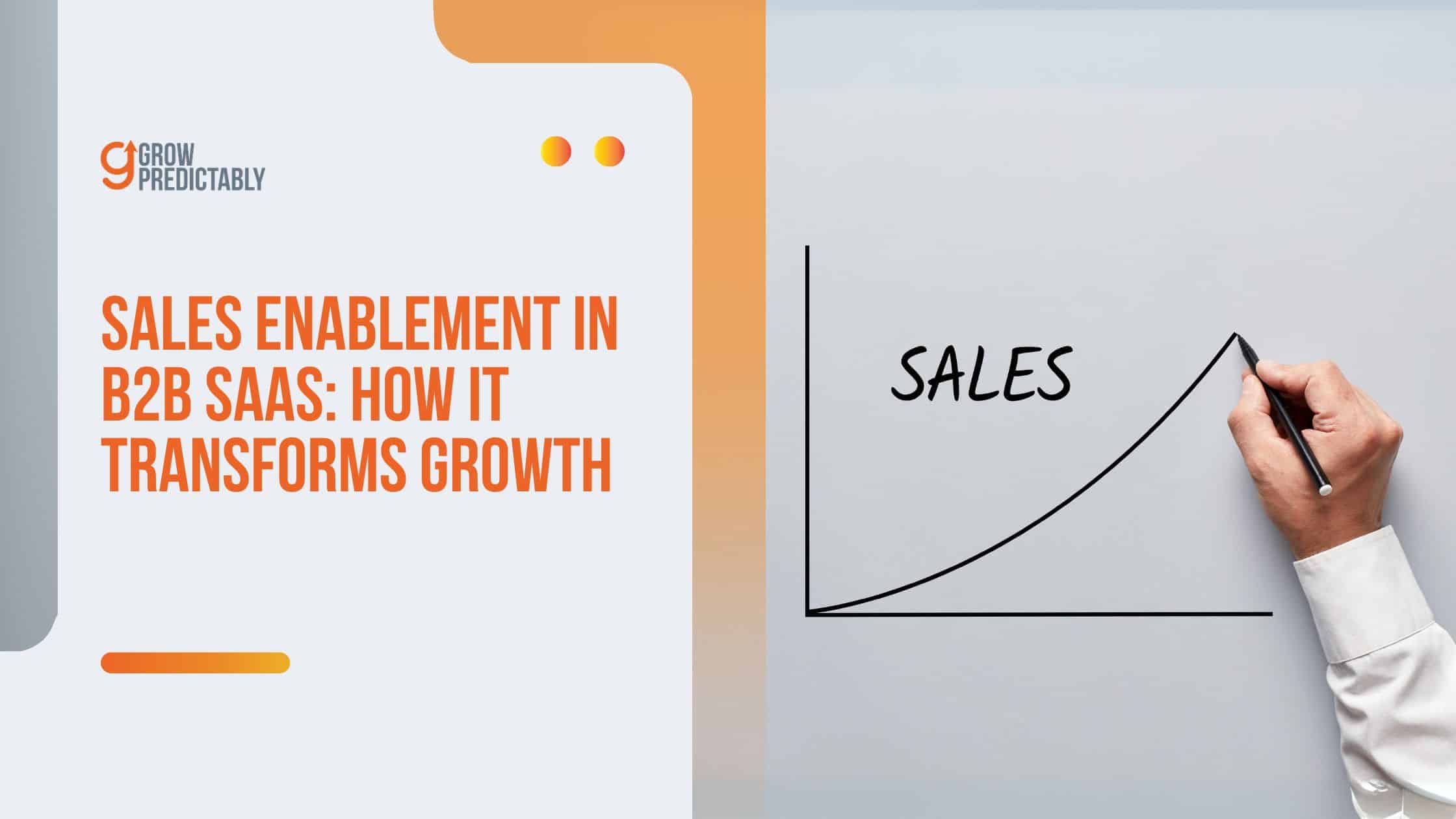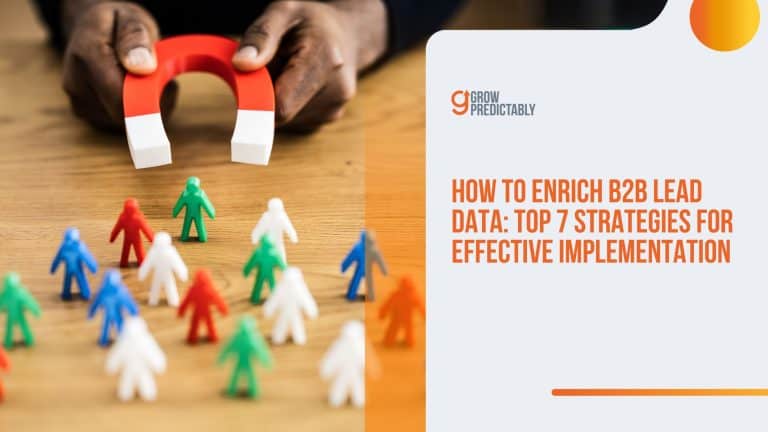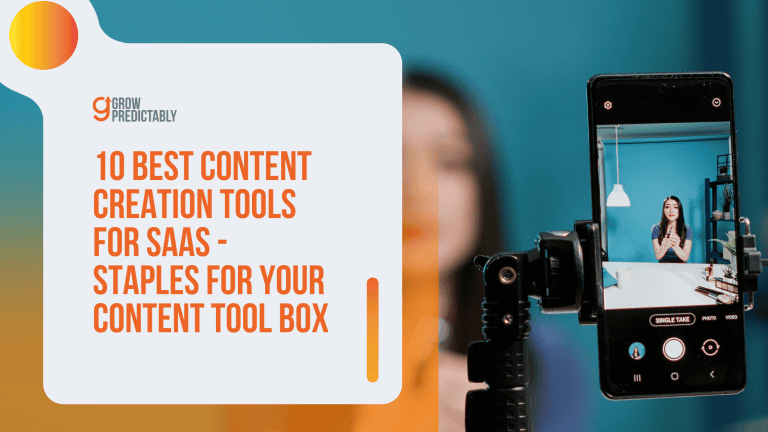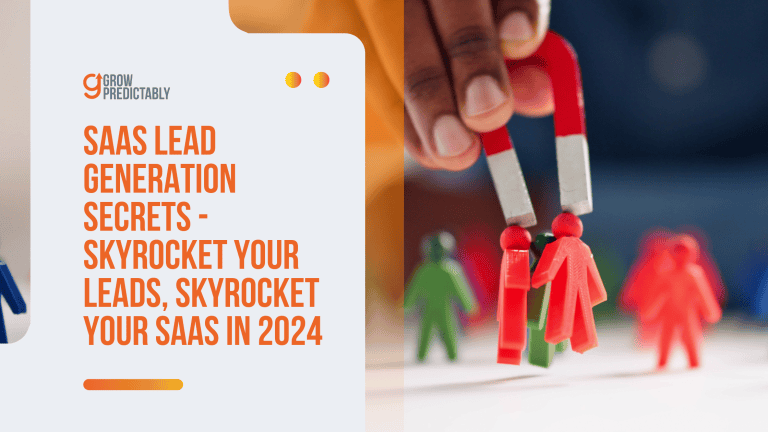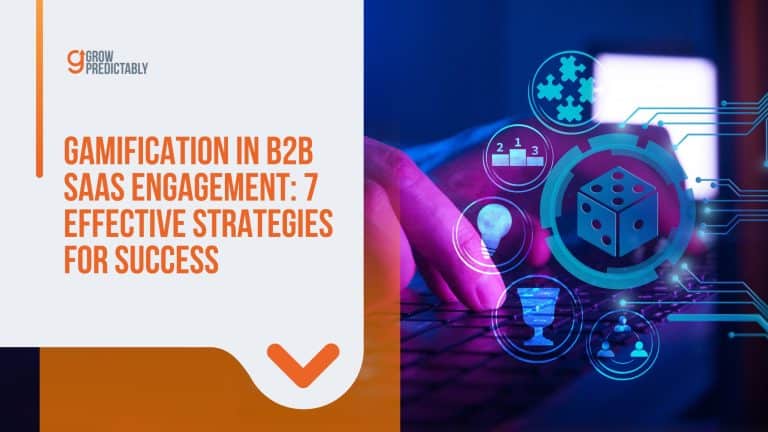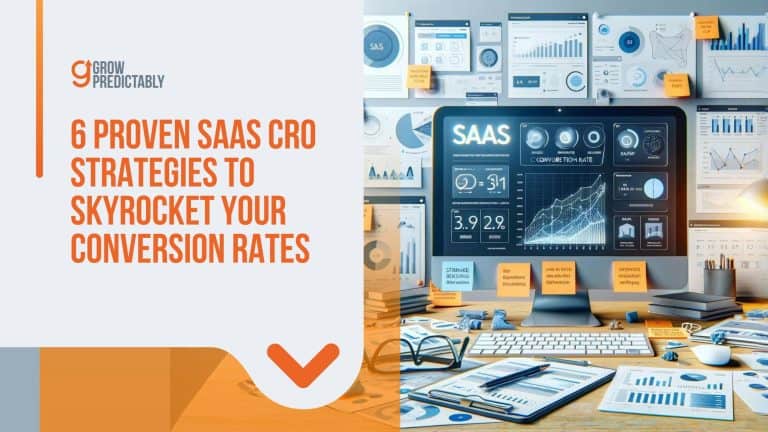Sales Enablement in B2B SaaS: How It Transforms Growth
When I first heard about sales enablement in B2B SaaS, I rolled my eyes.
Another fancy term for something simple, right? Wrong. This one strategy, known as B2B sales enablement, completely transformed how my sales team performed.
Reps closed deals faster, onboarding took half the time, and marketing finally worked for sales—not against them.
If your numbers aren’t where they should be, this might be the missing piece.
Want me to show you how to make it work?
Let’s dive in.
What is Sales Enablement?
Sales enablement isn’t just a support function – it’s your revenue multiplication engine.
A structured sales enablement process, built on a successful sales enablement strategy, is the difference between having a sales team that hopes to hit quota and one that systematically crushes targets month after month.
Here’s what it looks like in practice:
- Training That Makes Money: Not boring corporate workshops, but intense skill-building that directly impacts deal closure. Your team learns exactly what works in real sales situations, practices until it’s second nature, and executes with precision.
- Sales Enablement Tools That Close Deals: Every piece of tech, every document, every resource is designed to move deals forward faster. Nothing gets created or purchased unless it directly helps win more business.
- Content That Actually Sells: Materials that speak directly to customer pain points and objections. When a prospect asks a question, your team has powerful answers ready to go, backed by real data and success stories.
- Systems That Scale Success: Take what works from your top performers and turn it into a repeatable process that elevates your entire team. No more hoping people figure it out – you’re building a systematic approach to winning.
Sales enablement done right means every single rep on your team has everything they need to succeed the moment they need it.
It’s not about playing support – it’s about engineering predictable revenue growth.
Think of it this way: Your sales team is out there fighting for deals every day.
Sales enablement makes sure they never enter a fight unprepared.
Every rep, including newly onboarded sales representatives, becomes more effective, confident, and successful at closing business.
The end result?
Higher win rates.
Bigger deal sizes.
Faster sales cycles.
And most importantly – predictable, scalable revenue growth that puts distance between you and your competition.
Sales Enablement in B2B SaaS
Listen – your sales team needs weapons to win battles in the trenches.
The best product in the world means nothing if your team can’t communicate its value effectively or align it with strategic sales strategies using advanced sales enablement tools.
Sales enablement isn’t just some corporate buzzword – it’s the backbone that separates seven-figure SaaS companies from the ones that fade into obscurity.
Product sheets, demo videos, case studies, and email templates aren’t just “nice to haves.” They’re mission-critical assets that directly impact your bottom line.
Every moment your sales team spends creating their own materials is a moment they’re not closing deals.
And here’s the reality: your competition is arming their teams with sales enablement tools while yours is scrambling to piece together presentations.
The Collaboration Between Sales and Marketing
“Ninety percent of leadership is the ability to communicate something people want.”
Nitin Nohria
Forget everything you know about the traditional sales and marketing divide by ensuring seamless collaboration between sales and marketing teams.
In today’s market, companies that treat sales and marketing teams as separate entities are leaving millions on the table.
To set things clearly, sales teams that are well aligned with their marketing teams achieve more.
When you engineer your sales and marketing teams to operate as a single revenue-generating unit, you create an unstoppable force in your market.
The numbers don’t lie: companies with tight sales-marketing alignment among sales and marketing teams see 38% higher win rates and 36% higher customer retention.
Marketing teams don’t just create content – they’re building precision-guided missiles for your sales team.
Challenges and Benefits
The market punishes companies that half-commit to sales enablement and fail to adopt well-defined sales strategies.
If you’re not investing in your sales infrastructure, you’re actively choosing to lose deals.
The data is crystal clear: organizations with comprehensive use of sales enablement tools and robust sales enablement processes see 49% win rates compared to 42.5% for those without.
Utilizing sales enablement platforms, which includes features like coaching modules, analytics, content organization, and automation, can streamline sales processes and improve lead engagement and conversion strategies.
Companies that master this see their sales cycles shrink by up to 40% while driving deal sizes up by 25%.
What separates seven-figure sales organizations from the rest is their relentless focus on measurable outcomes:
- Decreased time-to-revenue through automated prospect qualification
- Increased deal velocity via AI-powered lead scoring
- Higher average contract values through strategic upsell automation
- Improved win rates through real-time competitive intelligence distribution
Looking Ahead
The Customer Value Journey isn’t just another framework – it’s a proven system that can be used to aid your sales process and turn your sales enablement into a revenue-generating machine through a well-structured sales enablement program.
What you’re about to learn will fundamentally change how you think about arming your sales team with a sales enablement program.
The reality of sales enablement is simple: it’s either a force multiplier for your revenue or it’s a massive waste of resources.
There’s no middle ground. Let’s dig into exactly how to make it the former.
Developing a Sales Enablement Strategy
A successful sales enablement strategy isn’t just another corporate initiative – it’s the backbone that transforms average sales teams into revenue-generating powerhouses.
When implemented correctly, as part of a successful sales enablement strategy, it becomes the driving force behind consistent quota attainment and predictable revenue growth.
Let’s break down exactly what makes a winning strategy work.

How to Develop a Sales Enablement Strategy
Your sales enablement strategy for your sales team is the difference between hoping for results and engineering them systematically.
A dedicated sales enablement team is crucial for implementing effective programs and ensuring strategic planning, team collaboration, and ongoing training.
The hard truth is that 82% of sales enablement initiatives fail because they’re built on shaky foundations.
Here’s what actually moves the needle:
- Revenue-Critical Focus: Every single component of your enablement strategy must be directly tied to revenue generation. This means ruthlessly eliminating any training, content, or processes that don’t demonstrably impact your bottom line. If sales representatives can’t immediately apply it to closing more deals, it doesn’t belong in your strategy.
- Cross-Functional Integration: Your sales strategies need to seamlessly connect marketing, sales, product, and customer success. This isn’t about playing nice – it’s about creating an unstoppable revenue engine where each department amplifies the others’ effectiveness.
- Data-Driven Evolution: Build measurement into your strategy from day one. Track leading indicators like content engagement rates and training completion but obsess over lagging indicators like time-to-first-deal and revenue per rep.
Aligning Sales Goals to an Enablement Charter
Your enablement charter, as part of a larger sales enablement strategy, isn’t just a document – it’s your battle plan for market domination.
Most companies get this completely wrong by creating vague, aspirational statements that sound good but drive zero results.
Utilizing a sales enablement tool can streamline this process by integrating with your existing customer relationship management systems, automating repetitive tasks, and providing essential data and resources to your sales teams.
- Quantifiable Objectives: Every single element in your charter needs concrete numbers attached to it. Don’t say “improve sales efficiency” – specify “reduce time-to-first-deal from 90 to 45 days within 6 months.”
- Resource Allocation: Detail exactly how much time, money, and headcount you’re dedicating to each enablement initiative. This forces prioritization and prevents resource dilution across too many projects.
- Accountability Matrix: Explicitly define who owns what, including specific deliverables and deadlines. Ambiguity kills execution – make it crystal clear who’s responsible for driving results.
Creating a Sales Enablement Plan
Your enablement plan is where strategy meets reality with a focus on efficient sales operations to ensure execution.
This is where you translate high-level vision into day-to-day execution that drives revenue growth, with a strong emphasis on sales operations to ensure structured processes and optimized workflows.
- Timeline-Driven Implementation – Break down your plan into 30, 60, and 90-day sprints with specific milestones. This creates urgency and prevents initiative drift.
- Tech Stack Integration – Map out exactly how your sales enablement tools will work together. A scattered tech stack destroys productivity – you need seamless workflows that make it easier for reps to sell.
- Success Metrics Framework – Build a comprehensive dashboard tracking both leading and lagging indicators. Measure everything from content utilization rates to time-to-revenue, and tie each metric directly to revenue impact.
The right enablement plan becomes your sales team’s operating system – systematically driving higher win rates, larger deal sizes, and faster sales cycles.
This isn’t about incremental improvements – it’s about creating a sustainable competitive advantage through superior sales execution enabled by a successful sales enablement strategy.
Integration of Sales Enablement with the Customer Value Journey
Every dollar your sales team earns depends on how equipped the sales team is and how well they guide prospects through specific stages of their buying journey.
Most companies are losing millions by failing to integrate their sales strategies and misaligning their sales enablement with these critical touchpoints.
Let’s fix that.

Awareness Stage Enablement
Your sales team’s first job isn’t selling – it’s establishing absolute authority the moment a prospect discovers you.
Your enablement strategy needs to arm your team with instant credibility builders.
Every first touch should trigger the thought: “These people actually know what they’re talking about.”
- Authority-building content that positions your solution as the obvious answer to their problems.
- Market research and competitive insights that demonstrate deep industry understanding.
- Quick-response frameworks that address prospects’ immediate pain points before they even ask.
Engagement & Subscribe Stage Support
The difference between losing a prospect and converting them into a subscriber lives in this stage.
Your sales team needs specific weapons to turn casual interest into active engagement.
Right now, your competition is probably losing 80% of potential subscribers because they don’t have these systems in place.
Convert Stage Acceleration
The conversion stage is where real money is made or lost.
Your sales enablement strategy needs to transform interest into revenue with surgical precision.
This means equipping your team with:
- Conversion-focused presentation templates that address buying objections before they arise
- ROI calculators and value demonstration tools that make purchasing decisions obvious
- Clear, compelling case studies that showcase specific, measurable results
Excite & Ascend Stage Mastery
Post-purchase enablement is where you multiply revenue.
Your sales team needs different tools here:
- Success playbooks that turn product adoption into guaranteed wins
- Upsell sequences that naturally lead customers to higher-value solutions
- Value-ladder presentations that make upgrades feel inevitable, not optional
Advocate & Promote Stage Amplification
Your existing customers are your most powerful revenue multipliers.
But most companies completely botch this opportunity.
Your sales enablement for advocacy needs:
- Advocacy activation systems that turn satisfaction into testimonials
- Referral generation tools that make promotion natural, not forced
- Success story frameworks that your customers can’t wait to share
The companies dominating their markets aren’t just enabling sales – they’re orchestrating every stage of the customer journey with military precision.
Each touchpoint needs specific sales enablement tools, training, and tactics.
Your job is to make sure your team isn’t just prepared – they’re unstoppable at every stage.
Sales Enablement Content
Your sales content needs to work as hard as your sales team does by leveraging modern sales enablement tools to enhance efficiency.
Think of it like having the right tools in your toolbox – you need the exact right ones to get the job done, starting with effective sales collateral produced by the marketing team to support the buyer’s journey.
Let’s break down what actually helps your team sell more and faster.
Creating Effective Sales Enablement Content
Most sales content sits unused because it doesn’t help close actual deals. It’s like having a garage full of tools you never use.
The marketing team plays a crucial role in creating and providing resources that support the sales enablement process.
Here’s what your team really needs:
- Battle-Winning Talk Tracks: Give your team exact words that work. Not fluffy theory, but real conversations that have helped close deals. Think of it as giving them a GPS with the fastest route to yes.
- Success Stories That Sell: Build case studies that show real problems and real solutions. When a prospect says, “prove it,” your team should have stories ready that show exactly how you’ve solved similar problems before.
- Answer Sheets That Work: Create clear, simple answers to every pushback your team hears. Like having a cheat sheet for every tough question that comes up in meetings.
Types of Sales Enablement Content
Your content arsenal needs to be locked and loaded with tools that move deals forward fast. Sales enablement tools, such as Seismic, empower your team to effectively engage and convert prospects by providing valuable insights for better decision-making.
Here’s the meat and potatoes of what your team needs to dominate their market:
- Money-Making Tools – Hand your team ROI calculators that show prospects exactly how much money they’re leaving on the table. Give them pricing guides that make complex deals simple to understand. Pack their arsenal with competitor comparison sheets that show why you’re the clear choice. These aren’t just documents – they’re deal accelerators that turn “maybe later” into “let’s do this now.”
- Industry Playbooks – Build comprehensive guides to empower sales representatives and make your reps sound like 20-year veterans in every industry they sell to. Break down the exact pain points that keep CEOs up at night in healthcare, manufacturing, tech, or whatever markets you serve. Map out the decision-making process, budget cycles, and regulatory hurdles. Include real quotes from actual buyers about what matters most to them.
- Sales Conversation Blueprints – Create step-by-step conversation guides for every type of deal and buyer. Map out discovery calls that uncover real pain points. Script objection handling that turns pushback into partnership. Build closing techniques that feel natural and get to yes faster. Your team should know exactly what to say and do at every stage of every deal type.
- Deal Acceleration Content – Develop email templates that actually get responses. Create meeting agendas that drive decisions. Build proposal templates that showcase value in terms your buyers care about. Every piece should move deals forward or it doesn’t make the cut.
- Buyer-Ready Visuals – Give your team simple, powerful visuals that explain complex ideas fast. Create infographics that show your impact at a glance. Build slides that tell your story without your reps needing to say a word. Make it easy for buyers to see your value and share it internally.
Best Practices for Sales Enablement Content Creation
Creating sales content is like cooking – you need the right ingredients and you need to know what works:
- Listen to Your Winners: Your best salespeople know what works. Get their secrets, write them down, and share them with everyone else. It’s like getting their winning recipe.
- Track What Works: Keep score of which content actually helps close deals. If something hasn’t helped sell in three months, fix it or dump it.
- Keep Making It Better: Talk to your sales team and marketing teams every month about what’s working and what’s not. Use their feedback to make your good stuff even better.
Remember, your content should be like having a great assistant – always there with exactly what you need, when you need it. If it’s not helping your team sell more, it needs to change or go.
Keep it simple, keep it practical, and keep it focused on helping your team win more deals.
Measuring Your Wins and Losses
“Accountability is the glue that ties commitment to the result.”
Bob Proctor
Most companies are flying blind, throwing resources at training and content without knowing if it’s actually driving revenue.
Incorporating effective sales enablement strategies can help measure wins and losses, ensuring that your efforts are aligned with driving better sales outcomes.
Your metrics aren’t just numbers – they’re the difference between dominating your market and watching your competition eat your lunch.
The Importance of Tracking Sales Enablement
Sales enablement isn’t a cost center – it’s a revenue multiplier.
But only if you’re measuring what actually matters.
Most sales leaders are tracking vanity metrics that look good in presentations but don’t translate to revenue.
Let’s fix that right now.
Key Metrics That Actually Drive Revenue
You need four critical metrics that directly impact your bottom line.
Every other number is just noise.
1. Time to Revenue
Your new reps are costing you money until they close their first deal.
Here’s what separates market leaders from everyone else:
- Tracking days from hire to first closed deal with military precision
- Measuring ramp-up velocity against industry benchmarks
- Identifying exactly where new reps get stuck in your sales process
90 days should be your maximum acceptable time to first deal. Every day beyond that is burning profit.
2. Win Rate Analytics
Raw win rates lie to you. You need to dissect them properly:
- Veteran vs. new rep performance gaps
- Deal size impact on win rates
- Sales cycle velocity tracking
A 15% win rate gap between veterans and new reps after 6 months means your enablement is failing. Period.
3. Quota Attainment Reality
Quota attainment isn’t just about numbers – it’s about predicting your company’s future:
- Monthly and quarterly attainment tracking
- Individual vs. team performance analysis
- Leading indicators that predict future performance
If less than 60% of your team is hitting quota, your enablement isn’t just underperforming – it’s actively holding your company back.
4. Customer Satisfaction Metrics
Customer feedback isn’t soft data – it’s your early warning system:
- Post-purchase experience scoring
- Recommendation likelihood tracking
- Sales process satisfaction measurement
A simple two-question survey immediately after purchase will tell you more about your sales effectiveness than a hundred internal reports.
These metrics aren’t just numbers on a dashboard – they’re your roadmap to dominating your market.
Start measuring what matters, and watch your revenue multiply. Everything else is just noise.
Setting Up Your Tracking System
Most companies are drowning in data while starving for insights that actually drive revenue.
Your tracking system needs to be a precision instrument for multiplying sales effectiveness and streamlining the sales process, not another administrative burden that slows your team down.
Building Your Revenue Intelligence Machine
Stop wasting time with manual tracking that kills productivity by empowering your sales enablement team to drive efficiency.
Here’s your execution blueprint:
- CRM Configuration: Transform your customer relationship management into a revenue intelligence command center by integrating it with sales enablement platforms that directly supports sales representatives. Every critical metric should be accessible in three clicks or less
- Automated Insight Generation: Set up dashboards that surface revenue-critical patterns automatically. If you’re manually pulling reports, you’re burning money
- Team Performance Visibility: Give your sales representatives real-time access to their metrics that matter. Blind spots in your data are costing you deals
- Seasonal Pattern Recognition: Identify and capitalize on performance trends before they impact revenue. Most sales teams react to patterns – market leaders predict them
The Value of Solid Numbers and Sales Enablement Tools
Let’s be clear: Operating without precise metrics isn’t just risky – it’s literally throwing money away.
Here’s what proper tracking reveals:
- Revenue leaks that are invisible to the naked eye
- Performance patterns that predict future results
- Training gaps that are killing your close rates
- ROI data that justifies every dollar spent on enablement
The companies dominating their markets aren’t just collecting data – they’re turning it into a weapon for multiplying revenue.
Your tracking system needs to be a profit center, not a cost center.
Every metric should drive decisions that impact your bottom line.
The difference between average and exceptional sales performance isn’t talent – it’s intelligence.
Give your team the data weapons they need, and watch your revenue multiply.
Everything else is just guessing.
And guessing is expensive.
Common Challenges in B2B SaaS Sales

Your sales challenges aren’t unique – but your response to them determines whether you dominate your market or get left behind.
Every obstacle in B2B sales is either a revenue block or a revenue opportunity.
Let’s turn your biggest headaches into your biggest advantages.
Long Sales Cycles: The Revenue Killer
Long sales cycles aren’t just frustrating – they’re actively destroying your profitability.
Every extra month in your sales cycle is burning cash and killing deals.
Here’s what actually works:
- Stage-specific content weapons that move deals forward faster
- Micro-commitment strategies that maintain momentum
- Video touch patterns that keep prospects engaged without being annoying
- Trigger-based nurture sequences that prevent deals from going cold
Your competition is letting deals die in long cycles by refining their sales process, and market leaders are closing in half the time.
The Multi-Stakeholder Maze
The “too many cooks” problem isn’t just inconvenient – it’s costing you millions in lost revenue.
Most companies try to please everyone and end up pleasing no one.
Here’s the solution that actually drives results:
- Stakeholder-specific battle cards that speak directly to each decision-maker’s priorities
- ROI calculators that make financial buyers say yes
- Technical validation frameworks that satisfy IT scrutiny
- User adoption roadmaps that win over end-users
A 37% reduction in sales cycle isn’t just a number – it’s pure profit added to your bottom line.
The Retention Reality
Retention isn’t a customer success problem – it’s a sales enablement challenge.
Every customer lost to misaligned expectations is revenue you’ve paid to lose.
Here’s how to fix it:
- Bi-weekly product intelligence updates that arm your team with current capabilities
- Reality-based selling frameworks that set proper expectations
- Success pattern recognition that predicts and prevents churn
- Alignment protocols that bridge sales promises and product delivery
A 23% jump in retention isn’t just keeping more customers – it’s multiplying your revenue without adding acquisition costs.
These aren’t just solutions – they’re revenue multiplication tools.
The companies crushing their competition aren’t just fixing problems – they’re turning challenges into competitive advantages.
FAQs
Your Next Move
Let’s get painfully clear about what’s at stake.
Sales enablement isn’t a nice-to-have – it’s the difference between market dominance and market irrelevance.
Most companies are leaving millions on the table with weak enablement strategies that lack the support of a cohesive sales enablement team, while their competitors are turning their sales teams into unstoppable revenue machines.
The market doesn’t care about your excuses – it only rewards results, and a focused sales enablement strategy ensures that.
Companies that nail their sales enablement strategy aren’t just hitting their numbers – they’re redefining what’s possible in their industry.
The tools, strategies, and frameworks we’ve covered aren’t just theory and can be used by sales teams to multiply success – they’re weapons that drive real revenue.
Your competition is either arming their teams with these capabilities or falling behind.
There’s no middle ground.
The future of your revenue depends on one decision: Are you going to turn your sales enablement into a precision instrument for market dominance, or keep watching your competition eat your lunch?
Let’s stop leaving money on the table and start building a sales machine that actually multiplies your revenue.
Everything else is just talk.

